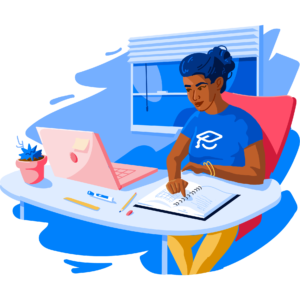Decoding visa requirements for international students can be challenging. Each country has their own set of policies and procedures, and you want your visa application process to be as easy as possible. Here, we’ll explore the student visa process in the United States and share best practices for acing your F-1 student visa interview (if required—more on that below.)
Before applying for your student visa, you’ll need to be accepted by an academic institution certified by the US Student and Exchange Visitor Program (SEVP).
Our ApplyBoard platform can help you find a program and institution in the US that matches your study abroad goals. Try it today!
US Student Visa Categories
Got your Letter of Acceptance? Before we dive in, let’s look at the three relevant visa categories:
- Student Visa (F-1): Reserved for students who will study at a high school, college, or university in the US, or study English at an English language institute.
- Student Visa (M-1): For students pursuing non-academic or vocational training in the US.
- Exchange Visa (J): Awarded to students who are participating in an exchange program at the high school or university level.

US Student Visa Application Process
After you receive your Letter of Acceptance, you’ll need to complete your visa application. As visa application steps and how you complete them can vary by US Embassy or Consulate, be sure to check the website for the embassy in your country.
Generally, you’ll need to complete an Online Nonimmigrant Visa Application, also called a Form DS-160. After completing this application online, you’ll need to print the confirmation page to bring with you to your visa interview.
After your application is complete, you should schedule a visa interview appointment at the US Embassy or Consulate in the country you’re living in. The US Department of State has a handy online tool you can use to see what the estimated wait time is for an interview in your country.

Interview Tips
If an F-1 visa interview is in your future, here’s how you can put your best foot forward.
Do Your Research
Whether it’s knowing that F-1 visas are non-immigrant visas (and tailoring your answers to show that you intend to return to your home country after graduating), or being able to answer specific questions about your program, having a solid foundation of knowledge will help you present thoughtful answers.
Practice Makes Perfect
Do practice interviews with a family member or friend, in person or on a video call. Can’t line up someone to practice on? Practice with your pets or plants—they won’t judge! It’s important to prepare your answers before the real interview. You’ll be more likely to give clear responses.
Consider Your Self
When you practice for the interview, have the person who’s asking you questions assess the content of your answers and non-verbal cues. Researchers have found that non-verbal cues like tone and body language can impact over half (55%) of a conversation.
Are you fidgeting when you reply? Playing with your hair or your shirt as you listen? Interviewers will notice this, and may not rank you as highly. On the positive side, speaking slowly and clearly can help you sound more confident. Also, making appropriate levels of eye contact can help you connect with the interviewer.
Considering other study abroad countries? Learn how to ace the UK credibility interview.

Make the Most of Each Question
Every interview will be different, but each one will touch on similar topics. Below, we’ll look at common interview questions, and suggest ideas to help you stand out.
Why did you choose to study in the US, instead of studying or joining the workforce in your home country?
- Share why you chose the program you did, and how your studies will help you get a great job in your home country.
- Share different job opportunities and salaries in your field that you could get with and without studying abroad.
Why did you choose this college or university?
- Be specific. Talk about things like the institution’s research excellence, reputation, or work-integrated learning opportunities.
- Tie the reasons you give to how they’ll help you meet your study goals.
- Share why this university or college is the best fit for you.
- Look up your institution’s ranking with Times Higher Education or Forbes. If you’re enrolling in robotics, and you’re attending a top-50 school for it, that knowledge can prove your study intent.
What are your test scores (i.e.: TOEFL, IELTS, GRE, GMAT, or SAT), your GPA, and what are you like as a student in general?
- Bring your test result copies to the interview if possible, for reference.
- While test results and GPA are important, they don’t show the whole picture. You can briefly speak to your athletic or community service achievements as well.
How are you funding your tuition and living expenses while studying abroad?
- You may have to share your exact tuition cost per year, so look it up beforehand on the ApplyBoard platform.
- If family members are supporting you, be ready to share their yearly salary as well as what they do for a living.
- Consider living expenses like rent, food, and insurance. Many institutions post student living expense averages on their websites. After you’re accepted, use those numbers to shape your budget.
If you’re planning to study in the US, setting and following a budget is crucial. Be sure to find out how much it costs to live in the United States before you start your program.Check out our blog on what kinds of insurance you’ll need as an international student in the US.
Are you planning to return to your home country after graduating?
- This question assesses your intentions. Because F visas are non-immigrant visas, it’s important to share that you plan to leave the US after your studies end.
- Strengthen your response by sharing some companies you plan to apply to post-graduation, or how you’d like to make an impact in your field.

With preparation, you’ll be ready for your F-1 visa interview. The night before, try your best to get a good sleep, so you’ll be alert, and remember to eat some breakfast—even if you’re nervous. You’ve got this!
Ready to search for study abroad opportunities in the US? Find programs from over 200 institutions on the ApplyBoard platform.



